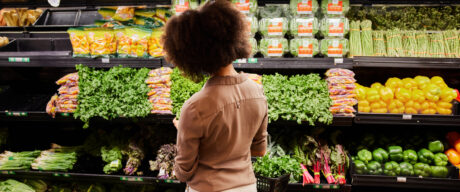If you’ve been waiting patiently for the federal government’s new grocery rebate to arrive, check your bank account. Rebates worth up to $628 started making their way to eligible Canadians along with the July 5 GST/HST credit payment.
Guidelines around rebate amounts and income limits have also been released. Let’s dig into them and find out the grocery rebate amount you might receive.
Grocery rebate amounts
Your grocery rebate is based on two things: your 2021 adjusted family net income and your family’s living situation — including household size and marital status — as of January 2023.
Income limits
Because the grocery rebate is intended for low-income families, you won’t receive it if your household income exceeds certain limits. In this case, those limits are the same ones used to determine eligibility for the January 2023 GST/HST credit.
| Living situation | Maximum income allowed |
|---|---|
| Single person | $49,166 |
| Single parent, one child | $55,286 |
| Single parent, two children | $58,506 |
| Single parent, three children | $61,726 |
| Single parent, four children | $64,946 |
| Married or common-law couple | $52,066 |
| Married/common-law, one child | $55,286 |
| Married/common-law, two children | $58,506 |
| Married/common-law, three children | $61,726 |
| Married/common-law, four children | $64,946 |
You won’t be eligible for the grocery rebate if you haven’t filed a tax return for 2021. The Canada Revenue Agency (CRA) provides the information and forms you’ll need to get started on your 2021 tax return.
Maximum payments
If you’re single and have no children, the maximum grocery rebate payment you can receive is $234. If you’re married or living as a common-law couple and have no kids, the most you’ll receive will be $306.
If you’re a parent, the amount you receive depends on how many children you have, regardless of your marital status:
- One child: $387.
- Two children: $467.
- Three children: $548.
- Four children: $628.
Keep in mind that those are maximum amounts. The higher your 2021 income, the smaller your grocery rebate is likely to be.
Haven’t received your grocery rebate?
The government originally estimated that around 11 million Canadians will receive the grocery rebate. Paying that many people might take some time.
If you haven’t received your rebate yet, the CRA encourages you to wait up to 10 business days — July 19 or later — before contacting them and attempting to rectify your situation.
Canada’s still-rising food prices
The Grocery Rebate comes at a time when inflation-driven food prices are still eating away at Canadians’ finances. Annual inflation was 3.4% in May 2023, lower than it’s been in a while. But the cost of food continues to rise at a much faster rate. Grocery prices in May were up 9% year over year.
According to Statistics Canada, the highest price gains were seen in edible fats and oils (up 20.3%), bakery products (15%) and cereal products (13.6%).
The price of food purchased from restaurants also continues to climb, rising by 6.8% in May after posting a 6.4% increase in April.
Because there are so many factors feeding into higher food prices — Hurricane Ian, packaging costs, energy costs and increased input costs like animal feed — it’s hard to predict when they might plateau.
Tips to save on groceries
Whether you’re in line for a Grocery Rebate or not, it may be time to try out some cost-saving strategies at the grocery store if you haven’t already:
- Buy frozen fruits and vegetables. Although the price of frozen fruits and vegetables is actually rising faster than that of fresh food, you won’t have to worry about throwing it out if you don’t get around to eating it in time.
- Switch brands. Lower-priced generic brands can often save you money without sacrificing quality, especially on processed or canned foods. It’s probably not a bad time to see what’s on the shelves at the discount food retailers in your community, too.
- Pay with points. If you’re a member of a grocery store’s loyalty program, cash in the points you’ve been hoarding to reduce your next grocery bill. The same goes if your credit card rewards can be applied to grocery purchases.
DIVE EVEN DEEPER

How to Save Money on Groceries: 10 Tips Anyone Can Try
Digital flyer apps, coupons and a rewards credit card are just some of the tools that can help you save money on groceries.

5 Survival Strategies for Times of High Inflation
Reassessing your budget, taking advantage of sales and rewards programs, and opening a GIC are ways to hedge against inflation.

How Stacking Credit Card Rewards Could Save You Big
Maximize your credit card rewards and earn more cash back by using spending categories to your advantage. Double up on offers and get exclusive perks.

13 Fuel-Efficient Tips to Help You Save On Gas
A combination of healthy driving habits, rewards programs, gas-friendly credit cards and apps will help you save at the pump.

